Key takeaways:
- Breakdancing fosters a strong sense of community through collaboration, mutual respect, and collective support, enhancing personal connections among dancers.
- Smooth transitions between moves are essential, showcasing a dancer’s skill, fluidity, and creativity while creating a cohesive performance experience.
- Preparation for performances involves mental readiness, proper warm-up, and visualizing routines to enhance confidence and execution.
- Community support and mentorship play a crucial role in personal growth, encouraging dancers to take risks and improve their skills together.

Understanding the Breakdancing Community
Breakdancing, or B-boying as it’s often called, is more than just a dance style; it’s a vibrant culture that stems from the streets, pulsating with energy and creativity. I remember my first time at a local jam, surrounded by a diverse crowd of dancers, spectators, and music, where every move told a story. It made me realize just how powerful the sense of belonging is within this community.
What I find fascinating is how breakdancing thrives on collaboration and respect. It’s not just about individual expression; many breakdancers form tight-knit crews, sharing techniques and encouraging one another. Have you ever experienced the thrill of locking eyes with someone across the floor and exchanging a nod of acknowledgment? That simple gesture can ignite a shared journey, fostering friendships that go beyond the dance.
Delving deeper into the community’s dynamics, it’s clear that breakdancing serves as an outlet for self-expression and social commentary. I’ve chatted with dancers who use their routines to convey personal struggles or to challenge societal norms. When you see someone executing a power move, it’s often a reflection of their resilience and passion. Doesn’t that make you appreciate the artistry even more?
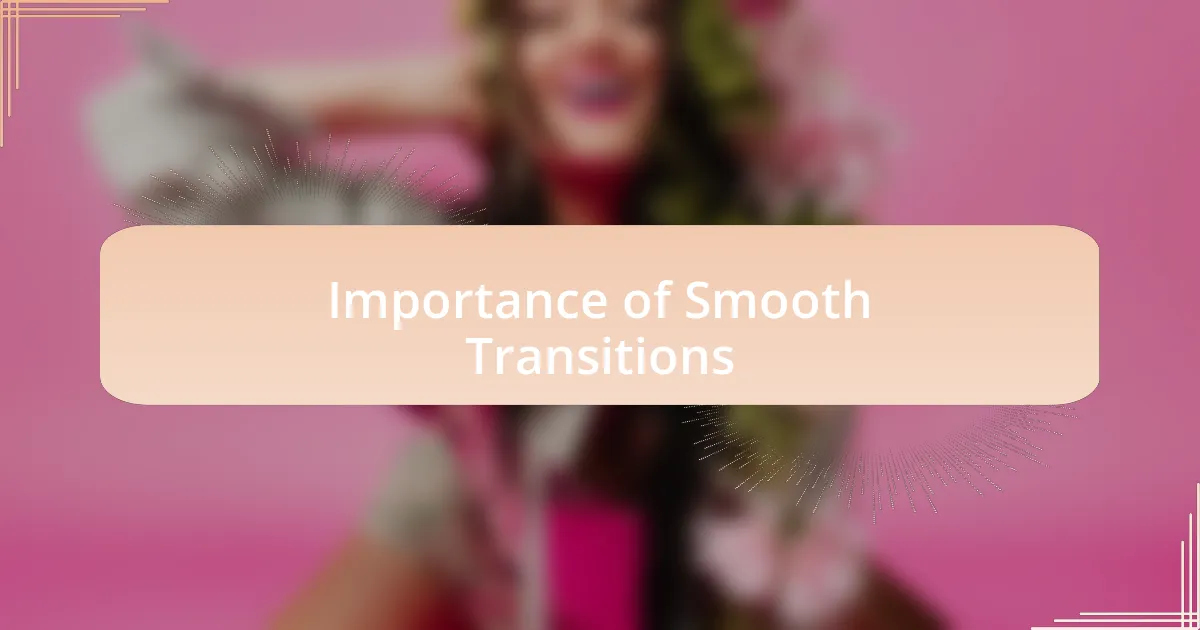
Importance of Smooth Transitions
Smooth transitions in breakdancing are crucial for maintaining the rhythm and flow of a performance. I recall a particular battle where one B-boy seamlessly transitioned from a windmill into an instantly recognizable freeze. The crowd erupted in cheers, and I felt the adrenaline rush—they appreciated not just the moves, but the fluidity that connected them. Doesn’t a smooth transition make you feel like you’re witnessing something truly magical?
Moreover, smooth transitions highlight the dancer’s skill and creativity. From my experience, when I practiced moving between power moves and footwork, it was like telling a story without words. Each transition was an opportunity to express emotion, whether it was joy or determination. Have you ever felt that moment in a dance where everything just clicks? That’s the power of effectively linking movements together.
In a community where every performance is a shared experience, smooth transitions create a sense of unity among dancers. I remember participating in cyphers where two dancers would engage in a back-and-forth of movements, each one relying on the other’s transitions to elevate the energy. It made me realize that these interactions not only showcase individual talent but also strengthen communal ties. Isn’t it incredible how movement can weave together connections among us?
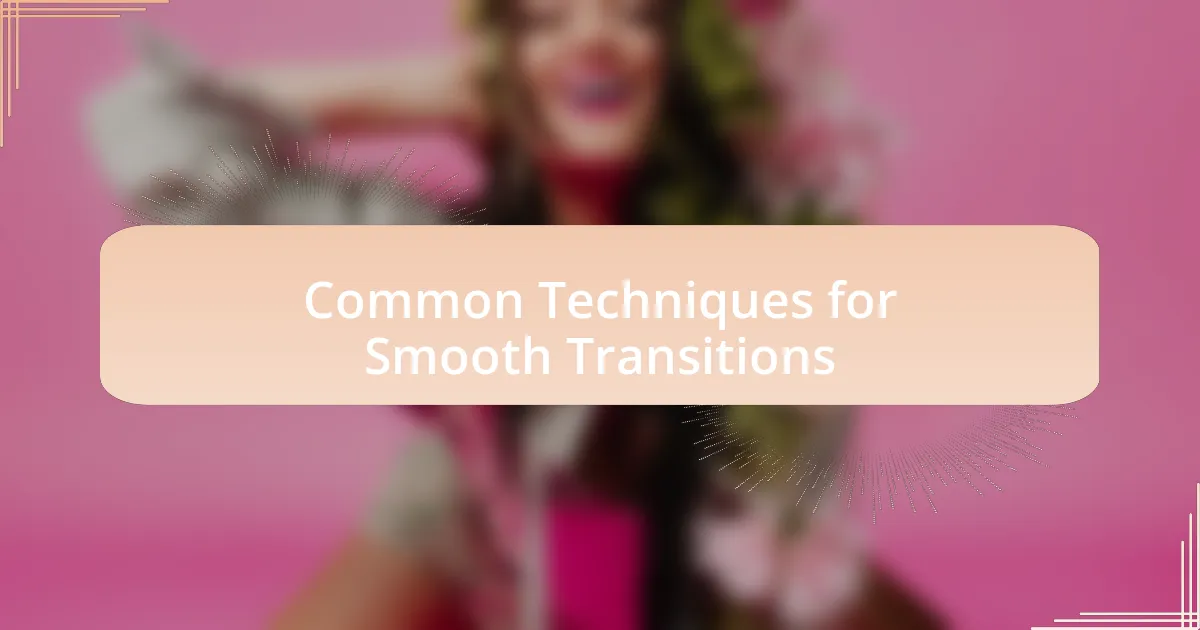
Common Techniques for Smooth Transitions
One effective technique for achieving smooth transitions is the mastery of momentum. I remember a time when I was trying to link a spin to my next move. Instead of abruptly stopping, I learned to harness the energy from the spin. This fluidity not only enhanced my performance but allowed me to glide effortlessly into the next section of my routine. Have you ever noticed how dancers seem to float from one move to another? That’s the beauty of momentum at play.
Another important technique involves understanding the space around you. In one of my early battles, I found myself restricted by my own fear of losing balance. However, as I grew more aware of my surroundings, I discovered the power of adjusting my spacing and positioning. I could connect my movements more naturally and confidently. Isn’t it fascinating how the environment can influence the way we dance?
Finally, I believe that practicing combinations can drastically improve transition smoothness. I often spent countless hours perfecting sequences, focusing on the seamlessness between each step. Each practice felt like a puzzle, where finding the right pieces made the overall picture more vibrant. Have you experienced the satisfaction of nailing a difficult sequence? That joy reinforces the importance of diligent practice in honing the art of smooth transitions.
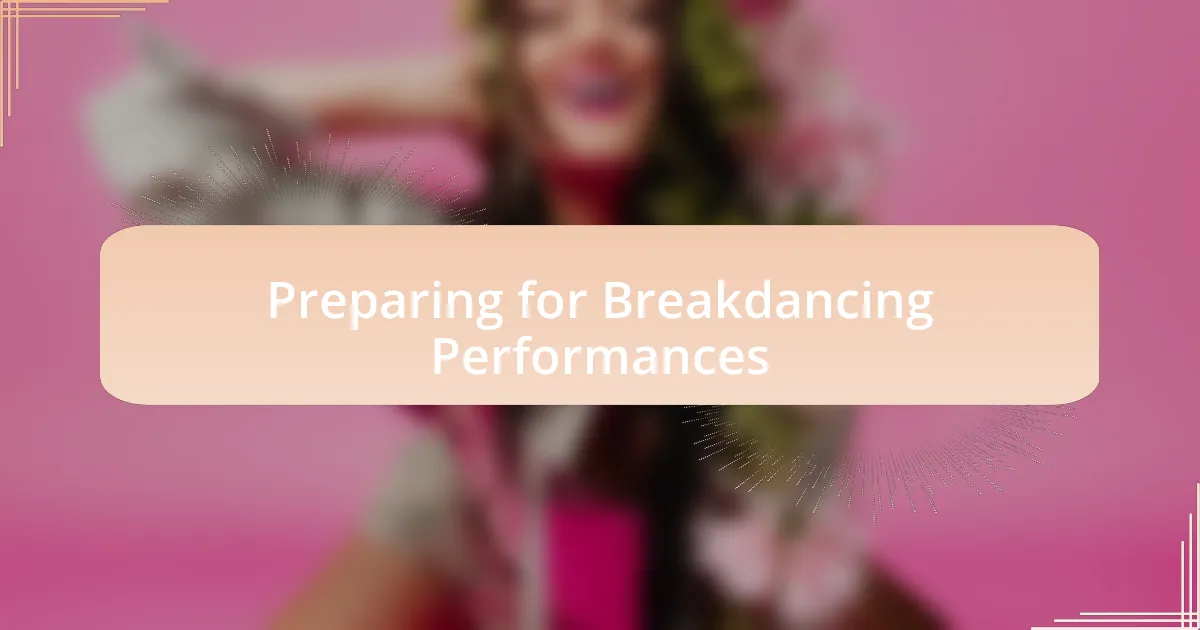
Preparing for Breakdancing Performances
Preparing for a breakdancing performance is as much about mental readiness as it is about physical preparation. I remember pacing nervously backstage, feeling the excitement and the pressure swirling inside me. It dawned on me that taking a few deep breaths helped calm my mind and focused my energy. How do you manage pre-performance jitters?
Another key aspect is warming up correctly. I can’t stress enough how beneficial a full-body warm-up is before hitting the stage. In one instance, I neglected this crucial step and felt tightness during my performance, which hampered my movements. That experience taught me the importance of getting my body ready to dance, ensuring I can move freely and connect my transitions smoothly.
Lastly, visualizing my routine has always been part of my preparation. Before stepping onto the floor, I often close my eyes and imagine each move flowing into the next. This mental rehearsal not only boosts my confidence but also makes the choreography feel second nature when the spotlight hits. Have you tried visualizing your performances? I find that it brings clarity and a sense of control, transforming anxiety into excitement.

Personal Experiences with Transitions
Transitioning between moves during a performance can be challenging. I vividly recall a competition where I felt like I was gliding through my routine until I hit a snag during a move change. The quick shift from a power move to a freeze left me feeling momentarily lost on stage, but it was in that moment I learned the value of practicing transitions repeatedly until they become instinctive.
One of my most memorable transitions happened during a local showcase. I had just nailed a complicated spin and was supposed to flow directly into a floor move. Instead of panicking, I remembered to lean into the music and let it guide my movements. Feeling the beat pulsing through me made that jump feel seamless, and it reinforced how important it is to connect emotionally with the rhythm while transitioning.
There have been times when I overthought my transitions, leading to stumbles. Now, I remind myself to channel my energy rather than overanalyze each movement. This shift in mindset has transformed my performances; I’ve found that allowing myself to flow naturally leads to more fluid transitions. Isn’t it interesting how mindset can alter our physical expression?
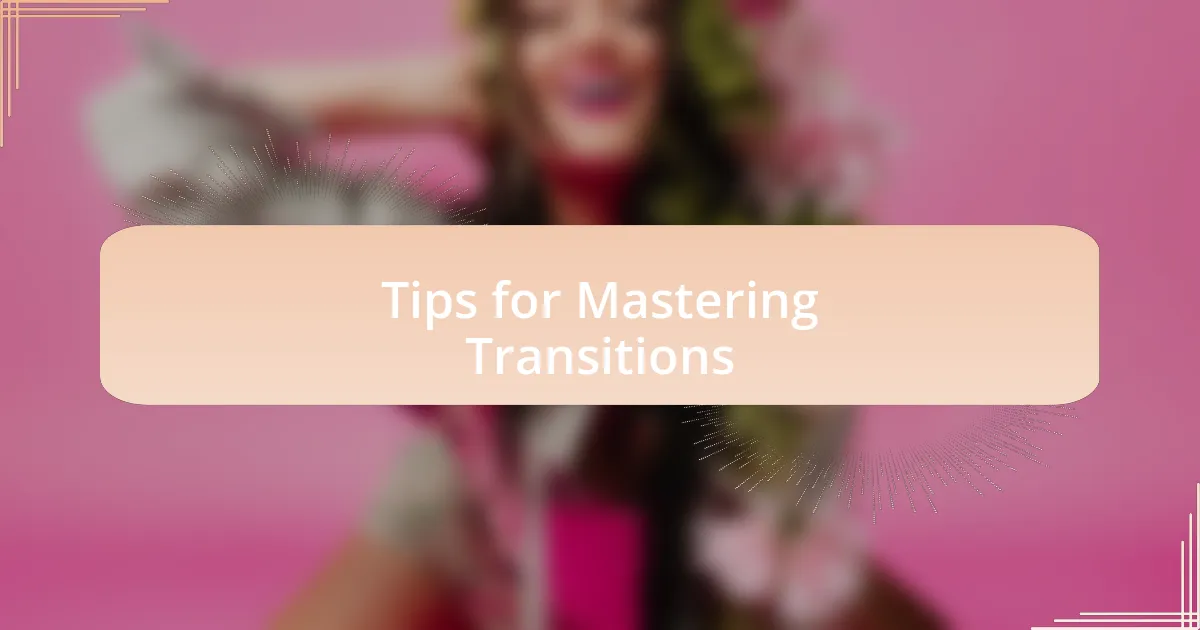
Tips for Mastering Transitions
Mastering transitions is all about practice and instinct. I remember when I first started breaking, I struggled with the flow from a headspin to a backspin. It took countless hours of drilling that specific movement pair. But once I committed to the repetition, my body learned to anticipate the shift, creating a sense of ease when I performed. Isn’t it fascinating how our bodies can adapt with enough dedication?
One trick that really helped me was visualizing the entire routine as a cohesive whole rather than segmented moves. This shift in perspective made transitions feel less intimidating. For example, during a performance, I focused not just on finishing a windmill but on how it seamlessly turned into a freeze. Approaching transitions this way instilled confidence, almost like a dance conversation where each move naturally leads to the next.
A pivotal lesson came from a live performance when I lost my spot in the music momentarily. Instead of freezing up, I decided to improvise. I quickly connected the last move to an unexpected pop, which surprised the crowd and added a spark to my routine. This experience taught me that flexibility in transitions is key; sometimes, unexpected changes can lead to the most memorable moments. Have you ever found that in your own practice or performances?
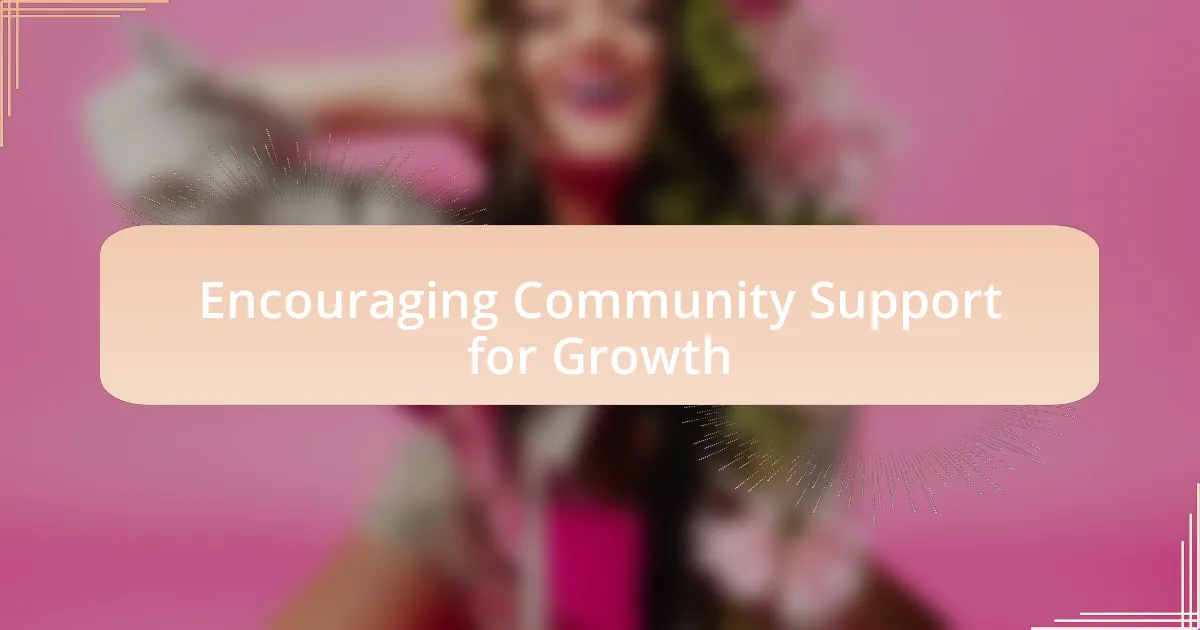
Encouraging Community Support for Growth
When I think about the role of community in breakdancing, I remember my first cypher. The energy was electric—everyone cheered for one another, creating an atmosphere of support that pushed me to try new moves without fear. Have you ever felt that sense of belonging? It’s this encouragement that fuels growth and helps dancers break out of their comfort zones.
Through my journey, I’ve learned that mentorship is vital within our community. I had the privilege of working with a seasoned B-boy who shared not just technical skills but also the mindset needed for improvement. His belief in my potential inspired me to work harder. It raises an important question: how can we give back to our community? Supporting fellow dancers, whether through feedback or guidance, strengthens our entire culture.
Moreover, hosting local events where dancers can showcase their skills is a fantastic way to build camaraderie. There’s something special about watching others shine and knowing your cheers and support contributed to their confidence. Have you ever participated in a community event? Those experiences are powerful reminders that collective support can elevate everyone involved.